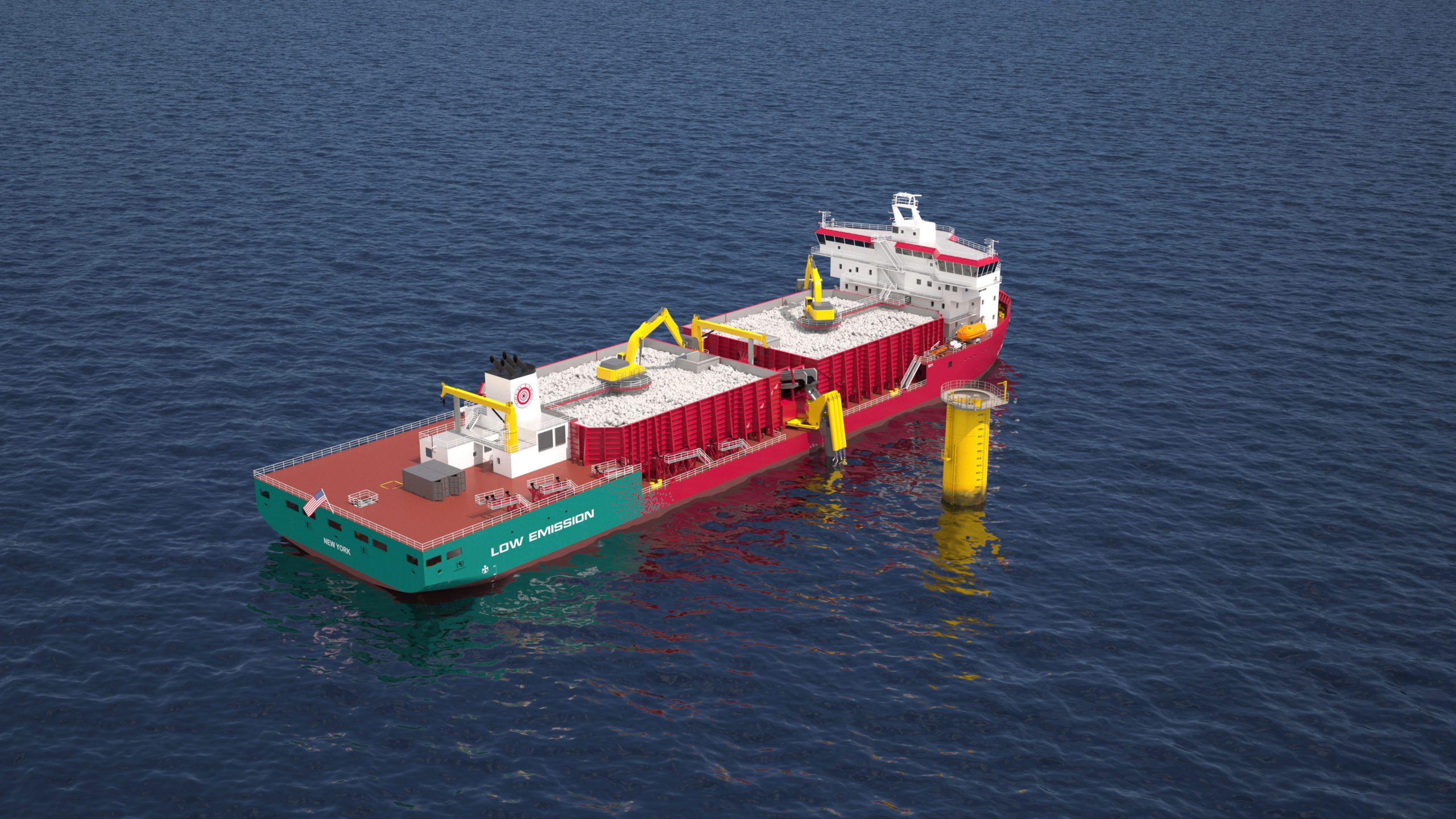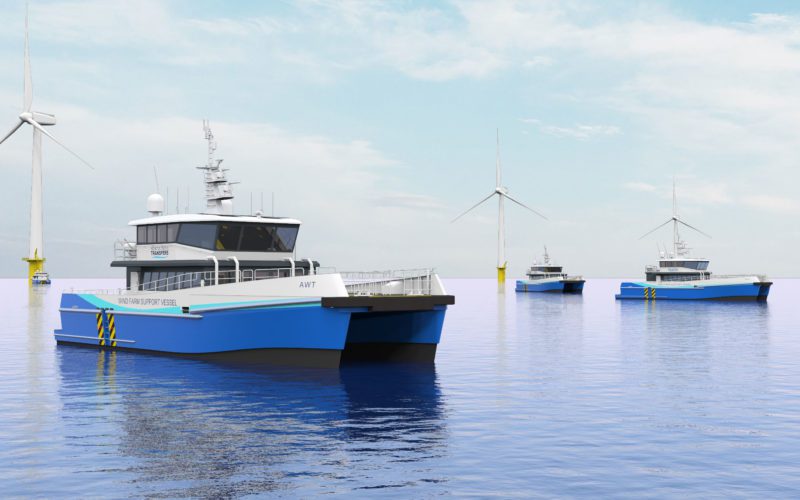
The rush is on to build U.S.-flagged vessels for the offshore wind industry
The United States has sprawling plans to dot waters off the East Coast from Massachusetts to South Carolina with wind farms. But for now, there are very few of these specialized boats in the U.S. fleet to build, service and operate them. That is starting to change following a flurry of contracting and construction activity over the last 18 months.
The federal government has leased 22 areas of ocean shelf to various companies and consortiums for the installation of offshore wind farms. Half of these leases were approved after 2017 — part of an ambitious plan to supply 35 percent of the nation’s energy via wind by 2050. There are other projects in various stages of planning and development for U.S. waters along the West Coast, Great Lakes and Gulf of Mexico.
The U.S. offshore wind industry has gone from mostly conceptual to booming in short order. This has pushed designers and manufacturers into a race to create Jones Act-compliant specialty vessels to meet its needs.
Installation vessels
Perhaps the most crucial ships for the nascent industry are the installation vessels. These “jack up” vessels are mechanical krakens that can deliver turbine towers up to 250 feet long to a point in the ocean and then extend their retractable legs to the seafloor to become platforms from which to build the turbines.
Keppel AmFELS, the Texas subsidiary of the global Keppel Offshore & Marine, is poised to produce the first Jones Act-compliant installation vessel. In February 2021, the company announced a partnership with the design firm GustoMSC to build a ship for Dominion Energy, which has leases for wind farms off the Virginia coast.
The vessel, Charybdis, will be 472 feet long and handle turbine sizes of 12 megawatts or larger and accommodate a crew of 119. It is under construction in Keppel’s shipyards and slated for completion by late 2023.
The price tag for Charybdis has been estimated at around $500 million, which may explain why other companies have hesitated to build an installation vessel. Some industry analysists have suggested working around the Jones Act, bringing in installation vessels from abroad and delivering the towers to them using U.S.-flagged feeder vessels, or having the towers shipped from Europe to address demand these pricy ships.
Fallpipe vessels
Great Lakes Dredge & Dock has announced plans to build a fallpipe vessel, which will transport and deposit loads of rock onto the seabed where it will help anchor and protect critical wind infrastructure. Ulstein Design and Solutions B.V is designing the 461-foot ship, which will be built by Philly Shipyard. The vessel is expected to cost almost $200 million.
Service operation vessels
Several companies have stated plans to create service operation vessels (SOVs), which are designed to act as floating bases for crews and tailored to offshore wind projects. For these specialized vessels, maneuverability and precision positioning are key.
Edison Chouest Offshore has begun building a service operations vessel for Ørsted and Eversource, partners in projects along the East Coast. Eco Edison will be docked in Port Jefferson, N.Y. The 260-foot vessel will have a diesel-electric propulsion system driving Voith Schneider propellers. Delivery is planned for 2024.
In May, Edison Chouest announced plans to build a plug-in hybrid SOV that will support Empire Offshore Wind. The vessel, to be based in South Brooklyn, N.Y., will be the first U.S.-flagged SOV capable of sailing partly on battery power.
Crowley and the Danish company ESVAGT have also announced plans to partner on a fleet of Jones Act-complaint SOVs.

Crew transfer vessels
Crew transfer vessels (CTVs) perform a unique job. They must quickly transport wind turbine technicians to an offshore wind site then push the CTV’s bow against the platform to allow for safe personnel transfers to and from the turbine. And they must perform this work in a variety of weather and sea conditions.
Blount Boats, of Warren, R.I., built the first two CTVs specific to the offshore wind industry. In 2016, Blount delivered Atlantic Pioneer, a 62-foot aluminum catamaran that serves Deepwater Wind’s Block Island Wind Farm — the first-ever U.S. wind farm. In March 2021, Blount delivered the 64.9-foot Atlantic Endeavor to Atlantic Wind Transfers to serve Dominion Energy’s Coastal Virginia Offshore Wind Farm.
Atlantic Endeavor was adapted from the Chartwell 24 plans by U.K. ship designer Chartwell Marine. The twin-hulled aluminum catamaran is equipped with MAN engines, Cummins generators, ZF transmissions, HamitonJet waterjets and Humphree interceptors.
Atlantic Wind Transfers, meanwhile, has ordered six new CTVs designed by Chartwell. They will be constructed by St. Johns Ship Building at its shipyard in Florida and will meet EPA Tier 4 emissions standards. The first vessels in the order are scheduled for completion in summer 2023 and early 2024.
Massachusetts-based American Offshore Services (AOS) has ordered four CTVs from Blount. They will be powered by four 700-hp Tier 3 Volvo Penta D13 engines paired with Volvo Penta IPS900 drives. The diamond-shaped catamaran hulls will have room for future conversion to a hybrid propulsion system.
Those vessels could be used to fulfill AOS’ contract with Ørsted and Eversource, which are collaborating on wind farms in waters near New York State. The two companies have chartered five CTVs, two from AOS and three from New York-based WindServe Marine. Senesco Marine of North Kingstown, R.I., is building the three WindServe vessels. They are expected for delivery in 2023 and 2024. In April, Windea Offshore USA announced agreements with St. Johns Ship Building for two new CTVs and with Gulf Craft for a third. The 98-foot vessels will feature a design from Incat Crowther. They are scheduled for delivery in 2023 and will operate for GE Renewables. The vessels will be stationed in New Bedford, Mass., to help construct the Vineyard Wind I development near Martha’s Vineyard.
Mayflower Wind, the consortium behind the wind farm of the same name proposed near Martha’s Vineyard, signed a deal with Gladding-Hearn Shipbuilding of Somerset, Mass., to build a hybrid-electric CTV to be delivered in the mid-2020s.
Gladding-Hearn also has a deal with Patriot Offshore Maritime Services to build an 88.6-foot CTV equipped with Scania engines driving HamiltonJet waterjets.
Other shipyards, including those on the West Coast, are also pursuing CTV projects, including SAFE Boats International, which partnered with Diverse Marine of the United Kingdom.
All American Marine and New Zealand’s Teknicraft have approval-in-principle from DNV for a 92-foot, quad-engine hybrid CTV with a projected speed of 29 knots.

